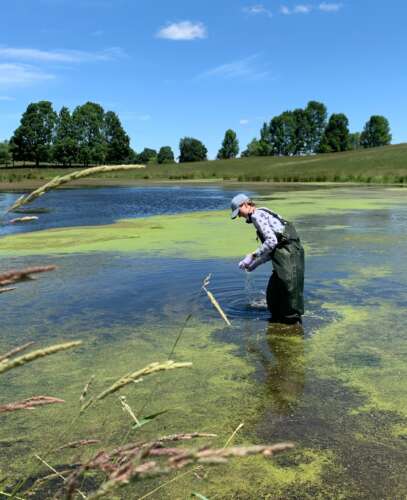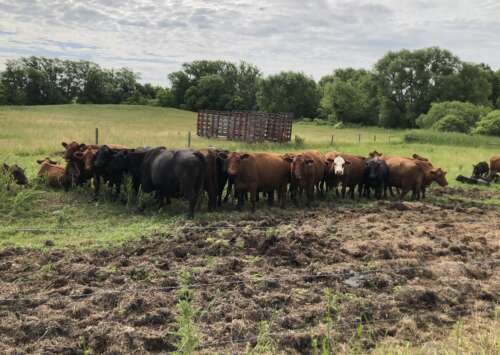Could a simple practice that sees farmers move their cattle from grazing area to grazing area result in healthier cattle and less pathogens that can cause human illness reaching our soil and waterways?
That’s what a multidisciplinary research team from the University of Guelph hopes to find out in a first-of-its-kind, multi-year study.

The team wants to learn whether “rotational grazing,” a practice in which farmers move their herd between multiple fenced-off grazing areas every few days, is beneficial to the collective ecosystem health compared to “conventional” grazing in which cattle graze the entire pasture at once.
The researchers are using a One Health approach to study these complex grazing systems. Nov. 3 marks One Health Day, a global campaign that seeks to address shared health challenges for humans, animals and the environment.
The U of G research team is collecting hundreds of water, soil and fecal samples from 10 beef farms across Ontario. Co-principal investigators Dr. Heather Murphy, Canada Research Chair in One Health, and Dr. Kari Dunfield, Canada Research Chair in Environmental Microbiology of Agro-ecosystems, are examining the impact of grazing practices on surrounding waterways and soil.
Ontario Veterinary College researchers Dr. Charlotte Winder and Dr. Nicole Ricker are examining herd health and antimicrobial resistance and Dr. Claire Jardine is studying the impacts on wildlife.
“The One Health approach is what makes our research study unique,” said Murphy, a professor in the Department of Pathobiology. “No one has looked holistically at the impacts of cattle grazing practices on the entire ecosystem before.”
Soil benefits of rotational grazing
“We already know that pastures have proven benefits for soil health and sequester more carbon compared to conventional grain-based agricultural systems,” said Dunfield, a professor in the School of Environmental Sciences. “We’re interested to see if there are additional benefits with rotational grazing systems.”
In rotational grazing, cow feces are distributed sequentially throughout the pasture, allowing the soil to uniformly absorb nutrients and increase water infiltration and biodiversity. The result is more nutrient-rich soil, more efficiently grazed pastures and greater potential to store carbon.
Increased water contamination after rainfall
As part of the study, which began in 2021, Murphy is collecting water samples to gauge groundwater and surface water contamination levels, particularly after rainfall. She notes that on conventionally grazed farms, cattle favour specific parts of the pasture resulting in a concentration of fecal matter.
“Following rainfall, the fecal matter may be washed out more readily into the surrounding waterways compared to rotationally grazed farms where it is spread more evenly,” said Murphy. “This leads us to believe that on rotationally grazed farms, the fecal matter has a better chance of drying out, allowing pathogens that could contaminate water sources to die off more quickly.”
Could rotational grazing reduce pathogens and limit antimicrobial resistance?
Another focus of the research is the impact on levels of antimicrobial resistant pathogens.
Antimicrobial resistance occurs when bacteria, viruses, fungi and parasites change to no longer respond to medicines, making infections harder to treat. All uses of antimicrobials such as antibiotics, antivirals, antifungals and antiparasitics are susceptible to resistance if used for extended periods.

On beef farms, these types of medications are used to treat or prevent disease in cows and can be passed through the cows’ fecal matter into the surrounding environment.
Ricker, also a professor in the Department of Pathobiology, is testing hundreds of collected fecal samples for antimicrobial-resistant bacteria. Preliminary results show lower levels of antimicrobial-resistant bacteria in samples gathered on rotationally grazed farms, which Ricker attributes to the overall health of rotationally grazed herds.
“We hypothesize that we will see lower incidence of disease on these farms, which could be attributed to less opportunities for cross-contamination from the herd’s fecal matter. Healthier cows require less medication, which translates into less antimicrobial-resistant bacteria being created and shed through their stool.”
Survey data collected during the study will also provide information on antimicrobial use and health outcomes of the herds being studied. According to Murphy, pathogens in the fecal matter could find their way into surface water and groundwater that we may end up drinking.
“Fewer organisms and resistant organisms reaching the environment is ultimately important for human health as we may see fewer waterborne and foodborne illnesses in humans due to exposure through recreation, drinking and irrigation.”
Defining future farming best practices
Rotational grazing has been around since the 1950s, yet adoption in certain industries has been slow. Implementation requires fencing that sections off parts of the pasture and a water source that can be easily accessible from various paddocks. This also means additional time investment for farmers, many of whom have multiple jobs.
“For our study, we tried to pair conventional and traditional farmers in the same geographic area for easy comparison,” said Murphy.
“For example, we have two neighbours, one is a conventional farmer, and the other is a rotational farmer. One has practiced conventional farming all his life and does not see the need to switch over. The neighbour practices rotational grazing and sees the health and yield benefits in his cattle.”
The research team hopes that real-life examples of farmers enrolled in the study will demonstrate to other farmers that rotational grazing practices are not only beneficial but attainable.
This research is funded in part by U of G’s Food from Thought research funding program, which supports the development of innovative solutions that improve the sustainability and productivity of agricultural production at global, landscape and micro scales.
Additional funding was provided in 2022 by the Beef Farmers of Ontario to expand the number of participants in this study to 10 beef farms across Ontario.
The multi-year research project is expected to wrap up by spring 2025.
Contacts:
Dr. Heather Murphy
heather.murphy@uoguelph.ca
Dr. Kari Dunfield
dunfield@uoguelph.ca
